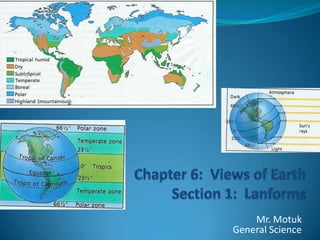
Chapter 6 section 1 (views of earth)
- 1. Chapter 6: Views of EarthSection 1: Lanforms Mr. MotukGeneral Science
- 3. Chapter 6 Section 1 I. Views of Earth Landforms A landform is a general feature of Earth’s surface. 3 Basic Landforms Plains: Large, relatively flat areas. Plateaus: Relatively flat, raised areas. Mountains: Elevated surface features.
- 5. Chapter 6 Section 1 Plateaus A plateau is a raised relatively flat area of land. Composed of horizontal bedrock uplifted by natural forces. Characterized by high, vertical cliff boarders. Example: Colorado Plateau Most famous is the Grand Canyon
- 6. Chapter 6 Section 1 Plains Plains are divided into two types. Coastal Plains: Broad areas along the oceans shore Sometimes called lowlands due to minimal elevation. Characterized by rolling hills, swamps, and marshes. Interior Plains Land locked, relatively flat, lowland areas. With thick fertile soil, plains are ideal for farming Usually between mountains and ranges.
- 7. Chapter 6 Section 1 Mountains Mountains rise high above the surrounding land. Mt. Everest is the highest mountain peak (in the Himalayan Mountains), 8,800 meters above sea level. (29,029 ft) Four main ways that mountains form: Folding Upwarping Fault Block Volcanic Activity
- 8. Chapter 6 Section 1 Types of Mountains Folded Mountains Formed by extreme opposing horizontal pressure. Like squeezing a pimple!!! Layers buckle and fold. Example: Appalachian Mountains Formed 300 to 250 million years ago. Oldest and longest mountain range in North America. Originally higher than the Rocky Mountains. Weathering and Erosion have reduced the height. Minersville: 1184 ft (yes we are in the Appalachian Mountain range!)
- 9. Chapter 6 Section 1 Types of Mountains Folded Mountains
- 11. Chapter 6 Section 1 Types of Mountains Up-warped Mountains Form by extreme upward forces. Erode exposing igneous and metamorphic bedrock. Characterized by sharp peaks and ridges. Examples Southern Rocky Mountains Black Hills (South Dakota) Adirondack Mountains (New York)
- 12. Chapter 5 Section 1 Types of Mountains Upwarped Mountains
- 13. Chapter 5 Section 1 Types of Mountains Fault Block Mountains Tilted faults slide diagonally in opposing directions. Fault: A fracture in the continuity of a rock formation caused by a shifting or dislodging of the earth's crust, in which adjacent surfaces are displaced relative to one another and parallel to the plane of fracture. Also called shift. Characterized by jagged peaks. Examples Grand Tetons (Wyoming) Sierra Nevada Mountains (California)
- 14. Chapter 5 Section 1 Types of Mountains Fault Block Mountains
- 15. Chapter 6 Section 1 Types of Mountains Volcanic Mountains Lava flows and produces a massive cone of igneous rock. Examples Mount St. Helens (Washington State) Mauna Loa (Hawaii)
- 16. Chapter 6 Section 1 Types of Mountains United States Elevations Highest Continental U.S Mount Whitney, California (14,494 ft) Highest U.S Mt. McKinley, Alaska (20,320 ft) Lowest Elevations Death Valley , California (282 ft below sea level) New Orleans, Louisiana (64 ft below sea level) Highest Pennsylvania Point: Mt. Davis (3,213 ft) Lowest World Elevation: Dead Sea (1,349 ft below sea level)
Notes de l'éditeur
- Presentation slide for courses, classes, lectures et al.